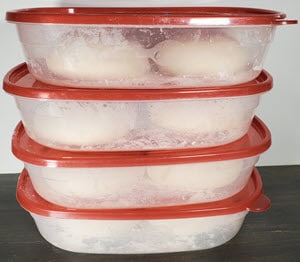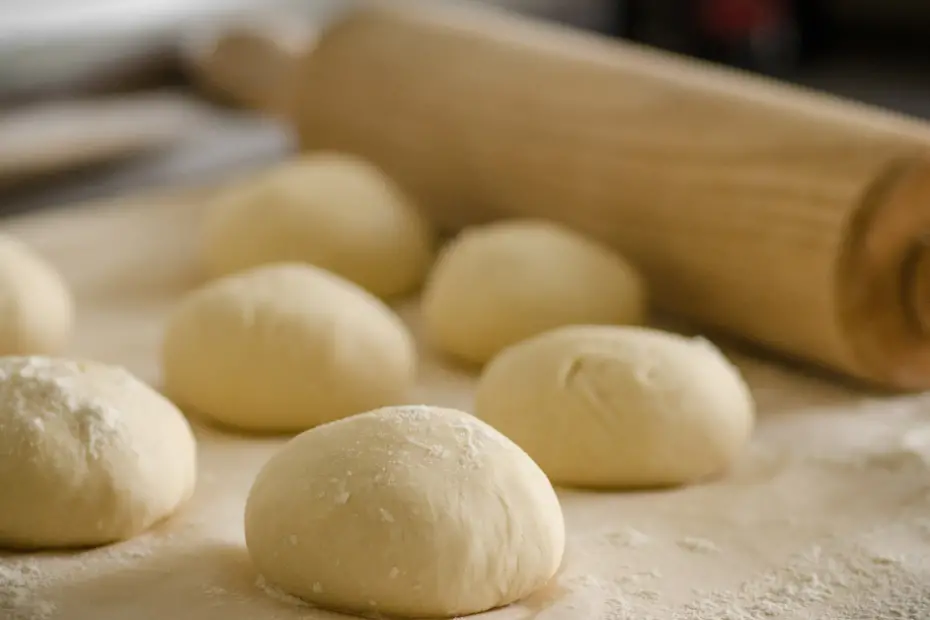Pizza dough is an essential ingredient for cooking a pizza. Unfortunately, pizza dough has an expiration date.
So, How Long Pizza Dough Lasts in the Fridge?
The shelf life of pizza dough in the fridge is between two and four days. Ultimately, it depends on the type of dough.
Knowing what type of dough, you’re working with and how long it lasts will keep you safe when preparing pizza. We’ll take you through what you need to know below. You’ll learn about the fermentation process, carbon dioxide’s influence, cold fermentation, and more.
DISCLOSURE: This post may contain affiliate links, meaning when you click the links and make a purchase, we receive a commission at no extra cost to you.
How to Store Dough
Homemade pizza dough lasts for a long time and you can make many meals with it. That said, its shelf life varies depending on how you store it. We’ll take you through the top three ways to store pizza dough.
Learning how to store pizza dough will help you with many pizza nights in the future. The most important aspect to understand is that fermentation changes depending on where the dough is stored.
How to Store Pizza Dough on the Counter
Pizza dough takes time to ferment. Plus, different types of pizza dough take different amounts of time to ferment. For example, Neapolitan pizza dough takes up to 8 hours to ferment, while standard pizza dough takes half that time.
To store pizza dough on the counter while it ferments we have a few quick steps for you to follow. We list these steps below.
- Create pizza dough with your favorite pizza dough recipe.
- Roll the pizza dough into individual dough balls.
- Coat the pizza dough balls in olive oil.
- Place the dough in an airtight container or plastic bag.
- Let the pizza dough ferment on the counter for 4 to 8 hours.

After following these steps you can either bake the pizza dough or store it for later in a fridge or freezer.
Also, if you’re making an authentic Neapolitan pizza it’s best to store the dough on the counter for 24 hours.
How to Store Pizza Dough in the Fridge
The refrigerator is a common place to store pizza dough. To store pizza dough in the fridge, the steps are similar to storing it in the freezer. The major difference is that pizza dough doesn’t last as long in the refrigerator.
However, you reap the benefits of cold fermentation when yeast is in the refrigerator. Below are the steps to store pizza dough in the fridge.
- Prepare the homemade dough by following your favorite pizza night recipe.
- Give the dough time to go through the fermentation process. Allow it to rise based on your recipe.
- Split the pizza dough into pizza dough balls.
- Coat the pizza dough in olive oil.
- Place the dough balls in a plastic bag or airtight container.
When storing the pizza dough balls in a plastic bag, it’s a good idea to use a bowl. Place the dough balls in the bowl and cover the bowl with plastic wrap. This prevents the plastic from sticking to the dough balls.
How to Store Pizza Dough in the Freezer
Storing pizza dough in the freezer isn’t hard. You just need a pizza dough recipe, an airtight container, and a few minutes.
Always start by making the pizza dough. If you plan on using pizza dough with yeast, give the fermentation process some time. We recommend giving the dough about an hour to rise on the counter before storing it.
Once you have the dough, you can follow these steps to store it in the freezer.
- First, get a good pizza dough recipe and prepare your pizza dough.
- Let the pizza dough ferment in bulk.
- Split the pizza dough into smooth dough balls.
- Coat the dough balls in olive oil.
- Place the dough balls in an airtight container or plastic bay.
- Let the pizza dough balls finish the fermentation process.
- Place the pizza dough balls in the freezer.
Every pizza dough recipe is different, so always check for tips within the recipe for freezer storage. Ultimately, the goal is to protect the pizza dough from freezer burn and visible freezer crystals.
How Long Can Pizza Dough Be Stored on the Counter?
Pizza dough lasts for a long time on the counter. In fact, the answer might shock you. Depending on the pizza dough, you can store it on the counter for up to 24 hours.

Still, there is some variation. Standard pizza dough only lasts for two or three hours before losing flavor. On the other hand, Neapolitan pizza dough takes up to 24 hours to ferment.
We always recommend letting pizza dough ferment for about an hour on the counter. Then, transfer it to the refrigerator to complete the fermentation process if you’re unsure.
How to Use Pizza Dough from the Counter
Baking pizza dough from the counter is simple. It’s easier than using dough from the freezer or the refrigerator. To use dough from the counter, simply place it in the oven to bake it.
How Long Can Pizza Dough Be Stored in the Fridge?
Pizza dough can be stored in the fridge for a decent amount of time. In the fridge, pizza dough typically lasts for between two and four days. Keep in mind that the type of dough is important.

For example, Neapolitan pizza dough may last longer than some other types of pizza dough.
Storing pizza dough in the refrigerator causes fermentation to occur at a slower rate. Therefore, standard dough lasts for up to one week in the refrigerator. Still, for the best flavor, we recommend only storing dough for up to four days.
How to Use Pizza Dough from the Fridge
Raw dough stored in the fridge isn’t challenging to use. That said, there are a few things you need to think about before baking it. We’ll take you through some steps to follow to maximize pizza dough from the fridge.

- Remove the pizza dough from the refrigerator and let it sit for 1 hour.
- Periodically check on the pizza dough until it’s room temperature.
- Knead the dough by hand and stretch it out.
- Place it in the oven at your desired temperature.
As long as you follow these steps you’ll have no problem cooking pizza dough from the fridge.
How Long Can Pizza Dough Be Stored in the Freezer?
The freezer is different from the fridge and counter because fermentation stops. When fermentation stops bread flour, yeast, milk, and other ingredients last for longer periods. Most types of pizza dough and pizza dough ingredients will last for up to three months in the freezer.

While you can store the dough in the freezer for even longer periods, we recommend against doing so. Storing pizza dough in the freezer for too long creates problems.
Carbon dioxide levels become inconsistent, freezer burn occurs, and you’ll notice an air bubble when baking the dough.
How to Use Freezer Dough
Pizza dough from the freezer is trickier to use than pizza dough from the counter or fridge. Thankfully, there are a few steps to follow that give you the best results.
We list these steps to use freezer dough below.
- Remove the dough from the freezer.
- Place the dough in the fridge to defrost the night before cooking pizza.
- Remove the pizza dough from the fridge.
- Let the pizza reach room temperature.
- Knead and stretch the dough before baking.
Alternatively, you can cook pizza dough from the freezer without using the fridge. To do so, remove the pizza dough about four hours before baking it. Give the dough time to reach room temperature on the counter.
How to Tell if Dough is Bad
Determining if pizza dough is bad will save you from a stomach ache. Plus, it’ll make your pizza taste better. The good news is that there are a few ways to tell if pizza dough is bad.
Smell
One of the best ways to determine if pizza dough is bad is to smell it. While smells are normal for pizza dough, others are not. In fact, some pizza dough is even meant to have a sour smell.
Pizza dough is often made with yeast, which rises. The fermentation process will cause the dough to have a slightly sour smell. In some cases, pizza dough with yeast will have a beer odor.
While these smells are normal, it’s when they’re too potent that it becomes a problem. If you first open the container and notice these smells it’s likely not a problem. On the other hand, you shouldn’t smell a stale beer odor when handling the dough.
It’s also important to note that over-fermentation won’t make dough “unsafe” to eat. Instead, too much yeast fermentation will ruin the flavor of the dough. In both cases, you should avoid using the dough.
Color
The color of pizza dough is a good indicator of whether or not it’s bad. First, look for patches of different colors of pizza dough. Most dough should be a beige color but sometimes you’ll find grey colors.
When you find patches of green or grey colors there’s a good chance mold is growing. Mold on the surface of pizza dough is a good sign that it went bad.
Depending on where you’ve stored dough, it may look different. For example, pizza dough in the freezer differs from pizza dough in the fridge. If pizza dough in the freezer has visible ice crystals (freezer burn), it’s gone bad.
Mold
Mold is another great way to determine if pizza dough has gone bad. Mold often grows on the surface of the dough and it happens fast. In fact, leftover dough on the counter will only last a few hours depending on its moisture content.
Depending on the type of pizza dough, the color of the mold will vary. Obvious signs of mold include grey color shades on the surface and changes in texture.
Mold will also take on other colors and change the texture of pizza dough. Pizza dough may begin to look “fuzzy.” Mold may also be found in more than one place on pizza dough.
Always check the shelf life of the type of pizza dough you’re using to avoid mold. Grey colors are also a sign of dead yeast activators, failed structure, and freezer burn.
Rising
Pizza dough is supposed to rise when you heat it in the oven, especially dough with yeast. Depending on how much yeast, the pizza dough will rise a little or a lot. With less yeast, testing dough in the oven isn’t the best idea.
For dough with a lot of yeast, cut a small piece and place it in the oven. Let the dough bake for a few minutes and check to see if the dough rises. If the dough does not rise, there’s a good chance it’s bad dough.
Active yeast tends to rise when cooked in ovens, so dough with yeast that doesn’t rise is unsafe to eat. When testing pizza dough in the oven, cook it at between 400 and 500 degrees Fahrenheit.
Texture
The texture is one of the quickest ways to know if pizza dough is bad. Over time, the texture of pizza dough will diminish. It may become slimy, cracked, or fail to rise in the oven.
Pizza dough needs to maintain moisture to cook properly, which is why you should check for signs of dryness first. If the dough has cracks or has collapsed on one side, it’s a bad idea to cook with it.
It’s also important to check the texture when it’s cooked. If you know it should be a crispy crust, the dough shouldn’t remain soggy after cooking for 30 minutes.
Pizza dough also shouldn’t have slime. If the dough is slimy it’s time to throw it out.
Taste
One of the most obvious ways to tell if pizza dough is bad is to taste it. Pizza dough should taste good, so when it tastes sour that’s a sign that it’s bad. While it’s more dangerous than other methods, the taste is the best way to know if it’s bad.
Pizza dough should taste like bread. Some pizza dough that’s made with dairy or yeast will have some more flavor. When you notice flavors that are off, it’s time to put the pizza down.
Keep in mind that pizza dough that calls for a lot of yeast will keep the sour taste. Just make sure it’s not too pungent.
Freezer Burn
Freezer burn is unique to pizza that’s stored in the freezer. You can tell when pizza dough has freezer burn because of the visible freezer crystals that form on the dough.
Pizza dough that has freezer burn won’t cook as well. To store pizza dough in a freezer we recommend using a freezer bag to prevent freezer burn.
Freezer burns result in a dough that doesn’t rise as much. It may also cook unevenly as other parts of the dough thaw faster when cooking. Some parts of the dough may also have uneven moisture levels.
Fortunately, freezer burn isn’t the end of the world. Let the pizza dough thaw on the counter or in the fridge to determine if it’s safe to eat.
Final Thoughts
Making sure your pizza dough is safe to eat is essential for your health. Consuming bad pizza dough leads to conditions like E. Coli, so be careful with storage times.
Also, make sure you keep an eye on mold growth and a sour smell. Whenever you’re unsure about leftover pizza dough, we recommend throwing it out to avoid problems.
Now that you know what to look for, the next time you make pizza dough storage should be a breeze!
As someone from Long Island, New York, Thomas knows what it takes to make a good pizza. He understands that it’s a combination of high-quality ingredients, well-rounded pizza ovens, and a little bit of love. From the dough of a Neapolitan-style pizza to the wood that powers a wood-fired pizza oven, he has you covered. Thomas’ love of pizza is what got him here and he hopes that you’ll enjoy pizza as much as he does soon.
